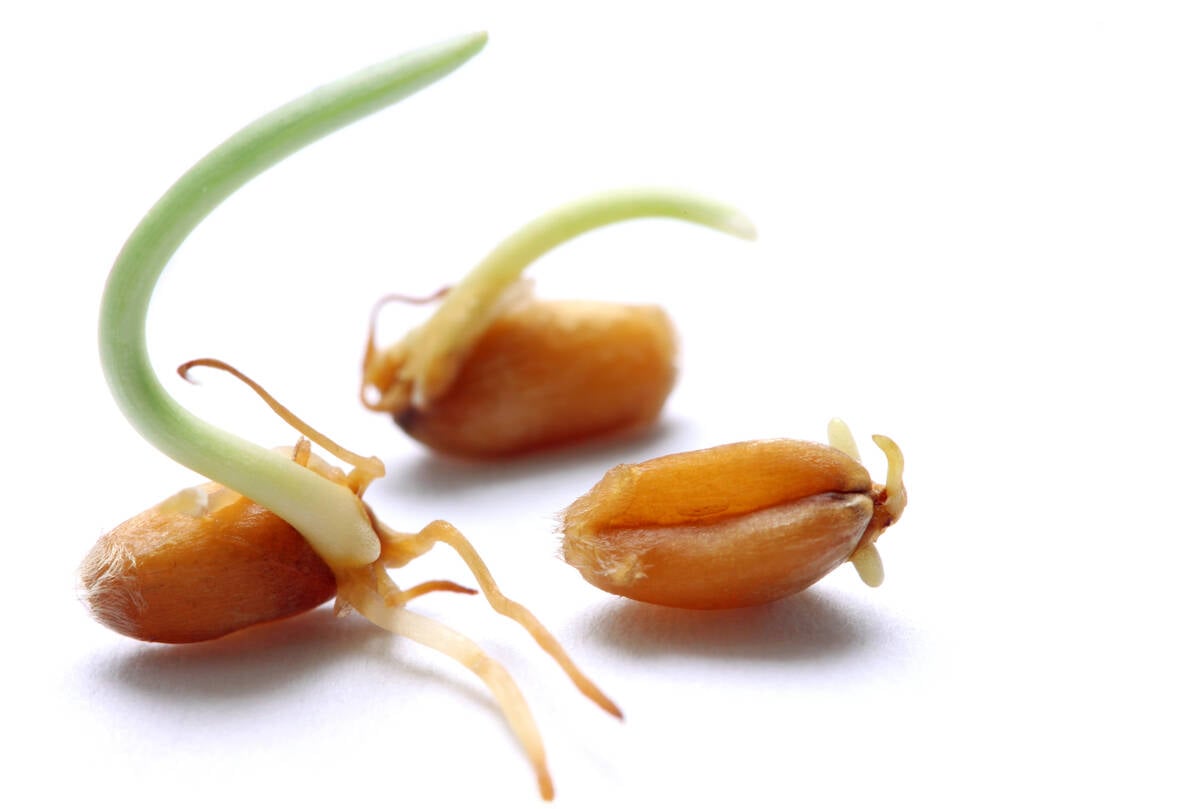Say the word Snowbird and most Canadians think of Anne Murray’s 1970s
hit of the same name, but for prairie farmers, that is about to change.
AC Snowbird is a hard white spring wheat scheduled to be grown on a
contract basis in 2003.
This Snowbird will spread its tiny wings and fly away to Asia to take
on the market dominance of Australia’s Prime Hard class in the noodle
market.
AC Snowbird is in seed multiplication this year. Quality Assured Seeds,
Read Also

Manitoba farmers fight sprouted wheat after rain
Rain in mid-September has led to wheat sprouting problems in some Manitoba farm fields.
which holds the rights to the variety, and the Canadian Wheat Board
plan to announce a contract program of several hundred thousand acres
in 2003 to get supplies for market development.
“We think there is some huge potential there for future growth and
these initial phases of market development are key to that,” said Kent
Hall of Quality Assured Seeds.
AC Snowbird and AC Kanata, another hard white wheat to be introduced in
2004, were developed at Agriculture Canada’s Cereal Research Centre in
Winnipeg.
Snowbird is a hollow-stemmed wheat with quality similar to hard red
spring wheat and a lighter coloured (bran) seed coat.
In co-op trials it yielded about six percent better than HRSW standard
AC Barrie. It is as tall as Barrie and has good lodging resistance.
It matures about one day later than AC Barrie.
AC Kanata, formerly known as AC Ivory, has a lower yield potential but
is 11/2 days earlier maturing than AC Barrie and its strong, short
straw provides superior lodging resistance.
“So it will probably carve out a niche in the northern areas where
maturity and lodging are issues and possibly into Manitoba in the (Red
River) valley where lodging is a prime issue,” Hall said.
This year’s weather problems are taking a toll on seed multiplication,
but Hall hopes there will be enough for a 250,000-300,000 acre market
development contract program in 2003.
“We will probably make the announcement around Christmas time about the
level of the premium and our plans for that,” said Patty Rosher of the
wheat board.
She said the board has already piqued the interest of some buyers with
a small market development program last year. A small quantity of seed
was sent to select customers.
“The customers really like it,” Rosher said.
“At the International Wheat Council meeting in Europe last month, one
of our Malaysian customers got up and said how Canadian hard white
wheat compares to the rest of the world. They said they would use it in
place of Australian hard white wheat for noodle applications.”
They also said they would use it instead of hard red spring wheat in
bread.
The attractions of white wheat are linked to its light coloured hull.
It allows millers to increase the extraction rate, that is, use more of
the wheat kernel and hull in the flour without darkening its colour.
Some markets put a premium on white flour.
“So you could have a white looking bread with more bran in it and it’s
presumably healthier and allows the miller to extract more flour.”
While it will be used in bread, the prime market is in Asian noodles.
The Canadian Prairie Spring white class was also designed to appeal to
this market but has had trouble making inroads due to kernel hardness,
although new varieties are tackling the problem.
The board thinks hard white wheat will have better success.
“It is a growing market, a large market and usually a premium market.
Some of our best customers, like Japan, Malaysia and Thailand, are big
noodle markets,” Rosher said.
The United States is also developing hard white wheat varieties for
this market, she said.
The market development arm of the American wheat industry, U.S. Wheat
Associates, estimates that if it had a strong competitive variety in
the class, it could increase wheat exports by 4.5 million tonnes, she
said.
To encourage white wheat production, the U.S. farm bill has budgeted
$20 million US over three years to encourage production on up to two
million acres.
Rosher said some of the grain used in last year’s market development
plan had a problem that has since been resolved. A percentage of the
plants produced red hulled seed, reverting back to a trait of one of
the parents.
Hall said the breeder seed line used for the program had a problem, but
“in the seed we are currently multiplying, that problem has been
cleared up and fixed and should not be an issue.”














